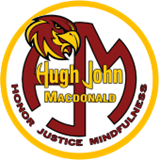The Bridge Program
January 6, 2022
The Bridge Program at Hugh John Macdonald
Andrea Ratuski, CBC The SCENE Producer | Wednesday November 21, 2012
What you get is students from all over the world and we're all making music together. And once we have that initial success, they're speaking the same language.
—Neil Watson, music instructor
The Bridge Program was conceived as a way of bringing music instruction to inner city students that wouldn't otherwise get music instruction," explains teacher Neil Watson, who is also a freelance saxophone player in Winnipeg.
Junior high school students at Hugh John MacDonald receive music classes twice a week. Up to 60 students begin with an hour of band practice, then a core group of students who are available to stay after school continue a more intensive class for an hour. The instruction is rooted in jazz and based around principles of learning by ear, rather than with music. "It's a completely voluntary class," says Watson, "so kids are here because they want to be here."
And it's really making a difference. "Aside from just the ability to play a musical instrument there's all kinds of things that we feel music students walk out of here with," says Watson. "They develop leadership skills. Students develop the ability to work in a team atmosphere. Confidence — students develop a sense of identity. They're musicians in the Hugh John MacDonald Orchestra. That's a big thing."
What makes the class unique is the fact that it is associated with the University of Manitoba and specifically the Faculty of Music. So often members of the faculty and senior students come by to help teach. "They'll play the music along with them and through osmosis these kids are getting better faster because they're sitting beside professional musicians so regularly," says Watson.
"I really believe that music is an international language," says Watson. "We have students here that don't speak much English at all.So it's hard to communicate on other levels. But here we are and we're playing music. And a lot of times I'll just point to a rhythm and we'll start clapping it. What you get is students from all over the world and we're all making music together. And once we have that initial success, they're speaking the same language."


